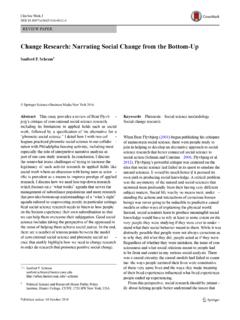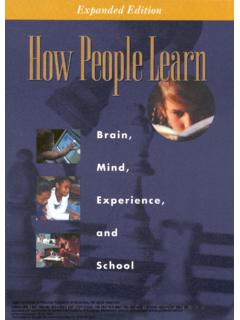Transcription of The Science of 'Muddling Through' - City University of New ...
1 The Science of " muddling through ". Author(s): Charles E. Lindblom Source: Public Administration Review, Vol. 19, No. 2 (Spring, 1959), pp. 79-88. Published by: Blackwell Publishing on behalf of the American Society for Public Administration Stable URL: . Accessed: 30/03/2011 15:00. Your use of the JSTOR archive indicates your acceptance of JSTOR's Terms and Conditions of Use, available at . JSTOR's Terms and Conditions of Use provides, in part, that unless you have obtained prior permission, you may not download an entire issue of a journal or multiple copies of articles, and you may use content in the JSTOR archive only for your personal, non-commercial use. Please contact the publisher regarding any further use of this work. Publisher contact information may be obtained at .. Each copy of any part of a JSTOR transmission must contain the same copyright notice that appears on the screen or printed page of such transmission.
2 JSTOR is a not-for-profit service that helps scholars, researchers, and students discover, use, and build upon a wide range of content in a trusted digital archive. We use information technology and tools to increase productivity and facilitate new forms of scholarship. For more information about JSTOR, please contact Blackwell Publishing and American Society for Public Administration are collaborating with JSTOR to digitize, preserve and extend access to Public Administration Review. The Science of muddling through By CHARLESE. LINDBLOM. Associate Professor of Economics Yale University > Short courses, books, and articles exhort admin- istrators to make decisions more methodically, but there has been little analysis of the decision-making SUPPOSE an administrator is given respon- process now used by public administrators. The usual process is investigated here-and generally de- sibility for formulating policy with re- fended against proposals for more "scientific" meth- spect to inflation.
3 He might start by try- ods. ing to list all related values in order of Decisions of individual administrators, of course, importance, , full employment, reasonable must be integrated with decisions of others to form the mosaic of public policy. This integration business profit, protection of small savings, of individual decisions has become the major con- prevention of a stock market crash. Then all cern of organization theory, and the way individuals possible policy outcomes could be rated as make decisions necessarily affects the way those de- more or less efficient in attaining a maximum cisions are best meshed with others'. In addition, of these values. This would of course require decision-making method relates to allocation of de- cision-making responsibility-who should make what a prodigious inquiry into values held by decision. members of society and an equally prodigious More "scientific" decision-making also is dis- set of calculations on how much of each value cussed in this issue: "Tools for Decision-Making in is equal to how much of each other value.
4 He Resources Planning.". could then proceed to outline all possible policy alternatives. In a third step, he would undertake systematic comparison of his multi- ployment. He would in fact disregard most tude of alternatives to determine which at- other social values as beyond his present in- tains the greatest amount of values. terest, and he would for the moment not even In comparing policies, he would take ad- attempt to rank the few values that he re- vantage of any theory available that general- garded as immediately relevant. Were he ized about classes of policies. In considering pressed, he would quickly admit that he was inflation, for example, he would compare all ignoring many related values and many pos- policies in the light of the theory of prices. sible important consequences of his policies. Since no alternatives are beyond his investi- As a second step, he would outline those gation, he would consider strict central con- relatively few policy alternatives that occurred trol and the abolition of all prices and mar- to him.
5 He would then compare them. In kets on the one hand and elimination of all comparing his limited number of alternatives, public controls with reliance completely on inost of them familiar from past controversies, the free market on the other, both in the light he would not ordinarily find a body of theory of whatever theoretical generalizations he precise enough to carry him through a com- could find on such hypothetical economies. parison of their respective consequences. In- Finally, he would try to make the choice stead he would rely heavily on the record of that would in fact maximize his values. past experience with small policy steps to pre- An alternative line of attack would be to dict the consequences of similar steps ex- set as his principal objective, either explicitly tended into the future. or without conscious thought, the relatively Moreover, he would find that the policy al- simple goal of keeping prices level.
6 This ob- ternatives combined objectives or values in jective might be compromised or complicated different ways. For example, one policy might by only a few other goals, such as full em- offer price level stability at the cost of some 79. 8o PUBLIC ADMINISTRATION REVIEW. risk of unemployment; another might offer process-usually describe the first approach less price stability but also less risk of unem- and not the second.'. ployment. Hence, the next step in his ap- The common tendency to describe policy proach-the final selection-would combine formulation even for complex problems as into one the choice among values and the though it followed the first approach has been choice among instruments for reaching values. strengthened by the attention given to, and It would not, as in the first method of policy- successes enjoyed by, operations research, sta- making, approximate a more mechanical proc- tistical decision theory, and systems analysis.
7 Ess of choosing the means that best satisfied The hallmarks of these procedures, typical of goals that were previously clarified and the first approach, are clarity of objective, ex- ranked. Because practitioners of the second plicitness of evaluation, a high degree of com- approach expect to achieve their goals only prehensiveness of overview, and, wherever partially, they would expect to repeat end- possible, quantification of values for mathe- lessly the sequence just described, as condi- matical analysis. But these advanced proce- tions and aspirations changed and as accuracy dures remain largely the appropriate tech- of prediction improved. niques of relatively small-scale problem-solving where the total number of variables to be By Root or by Branch considered is small and value problems re- stricted. Charles Hitch, head of the Economics For complex problems, the first of these Division of RAND Corporation, one of the two approaches is of course impossible.
8 Al- leading centers for application of these tech- though such an approach can be described, it niques, has written: cannot be practiced except for relatively sim- ple problems and even then only in a some- I would make the empirical generalization from what modified form. It assumes intellectual my experience at RAND and elsewhere that oper- ations research is the art of sub-optimizing, , of capacities and sources of information that solving some lower-level problems, and that diffi- men simply do not possess, and it is even more culties increase and our special competence di- absurd as an approach to policy when the minishes by an order of magnitude with every level time and money that can be allocated to a of decision making we attempt to ascend. The sort policy problem is limited, as is always the of simple explicit model which operations re- case. Of particular importance to public ad- searchers are so proficient in using can certainly ministrators is the fact that public agencies reflect most of the significant factors influencing traffic control on the George Washington Bridge, are in effect usually instructed not to practice but the proportion of the relevant reality which the first method.
9 That is to say, their pre- we can represent by any such model or models in scribed functions and constraints-the politi- studying, say, a major foreign-policy decision, ap- cally or legally possible-restrict their atten- pears to be almost trivial. tion to relatively few values and relatively Accordingly, I propose in this paper to few alternative policies among the countless clarify and formalize the second method, alternatives that might be imagined. It is the 1 James G. March and Herbert A. Simon similarly second method that is practiced. characterize the literature. They also take some im- Curiously, however, the literatures of deci- portant steps, as have Simon's recent articles, to de- sion-making, policy formulation, planning, scribe a less heroic model of policy-making. See Or- and public administration formalize the first ganizations (John Wiley and Sons, 1958), p. 137. 2 Operations Research and National Planning-A.
10 Approach rather than the second, leaving pub- Dissent," 5 Operations Research 718 (October, 1957). lic administrators who handle complex deci- Hitch's dissent is from particular points made in the sions in the position of practicing what few article to which his paper is a reply; his claim that preach. For emphasis I run some risk of over- operations research is for low-level problems is widely accepted. statement. True enough, the literature is well For examples of the kind of problems to which op- aware of limits on man's capacities and of the erations research is applied, see C. W. Churchman, inevitability that policies will be approached R. L. Ackoff and E. L. Arnoff, Introduction to Opera- tions Research (John Wiley and Sons, 1957); and J. F. in some such style as the second. But attempts McCloskey and J. M. Coppinger (eds.), Operations Re- to formalize rational policy formulation-to search for Management, Vol.


